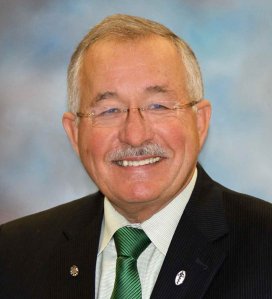Michigan State University fostered a culture that was more focused on protecting the school than the survivors of serial abuser Larry Nassar, a report released Thursday by the Michigan House of Representatives said.
State lawmakers conducted their own investigation of MSU’s handling of complaints against the former sports doctor to identify possible policy solutions. The House sent their findings to law enforcement for consideration in the Michigan Attorney General’s investigation of MSU’s handling of the Nassar case.

“The Attorney General appreciates the work done by the Michigan House of Representatives,” the attorney general’s office said in a statement. “The investigative team will be reviewing the report.”
The report marks the first time the state legislature has commented publicly on the Nassar case. It is one of many steps taken by lawmakers and law enforcement to figure out how multiple institutions failed hundreds of Nassar’s victims — many of them minors — for over 30 years. Nassar was sentenced to 40 to 125 years in prison for his crimes in both Ingham and Eaton counties.
MSU did not immediately respond to a request for comment.
These are some of the report’s findings:
243 people have reported Nassar to MSU since 2014
From 2014 to the present, 243 people reported abuse to the Michigan State University Police Department, according to the report. Most of those who reported abuse were minors at the time.
The House report also noted that 91 other Title IX complaints were filed against Nassar since Rachel Denhollander filed a Title IX complaint against him in 2016. Denhollander spoke to the Indianoplis Star in 2016, and, after her interview, many others came forward to tell their own stories of sexual assault and harassment at the hands of Nassar.
MSU ‘failed to properly investigate’
Amanda Thomashow, a former MSU student, filed a Title IX complaint against Nassar in 2014. The school conducted an investigation and determined that Nassar’s conduct did not violate the school’s sexual harassment policy.
But the House report states that MSU “failed to properly investigate” Thomashow’s complaint for a number of reasons.
For one, the investigation was based on “flawed testimony” from “biased medical experts,” the report said. Each expert worked with Nassar or knew him personally, and Nassar handpicked one of them, according to the report.

Moreover, the experts’ explanations were “fallacious at best” and only “provided circular justifications” for what Nassar claimed were legitimate medical treatments, the report states.
The report also points out that Thomashow received a different final report than Nassar. Thomashow’s report did not include the new requirements Nassar would need to follow when practicing similar procedures on patients. Nassar’s did. The discrepancy “demonstrates an office culture more focused on protecting the institution than survivors,” the report states.
MSU ‘defiantly’ stands by its 2014 investigation
The report notes that MSU continues to “defiantly and wrongfully maintain” it did not mishandle the 2014 Title IX investigation. MSU still defends the conclusions of their 2014 investigation, arguing that the facts of Thomashow’s case were “materially different” from a later investigation, which “reached the opposite conclusion,” the report states.
Nassar didn’t keep medical records on everything
Medical records for many of what Nassar called his treatments were not kept, the report found. In the medical records that were kept, they didn’t include any mention of or reference to the more sensitive parts of his treatments, like intravaginal penetration.
In other cases, MSU destroyed medical records of people who reported abuse or harassment to MSU police later, but they were all destroyed in accordance with state law and MSU’s record retention policy, according to the report.
Nassar grew more comfortable with abuse over time
While Nassar initially took more care to make his treatments seem medically appropriate when he began these treatments in the 1990s, as time went on, he grew more comfortable with his conduct. Initially, Nassar would explain the procedure and demonstrate on a pelvic model.

By the 2000s, he would only mention to victims that he was going to “adjust the pelvic bones.” By 2014, he felt comfortable enough to abuse his patients without any prior explanation when performing the “treatment,” according to the report.
“By 2016, he was self-assured enough to readily admit to investigators that he ‘does not get written consent from the patient before treatment’ and even testified that ‘unless the patient stops him, he is assuming the patient understand.’ ”
MSU sexual assault and harassment policies are changing
MSU has changed a number of policies and procedures regarding sexual harassment and assault since Nassar was suspended from MSU in 2016. The Office of Institutional Equity, the office within the university that handles Title IX complaints, only had three staff members in the 2014-2015 academic year, the staff increased to seven the following year. The office now has ten full time staff members, according to the report.
Nassar’s former boss charged
William Strampel, the former dean of MSU’s College of Osteopathic Medicine, is accused of using his position to sexually assault, harass, and solicit nude photos from female students, according to a criminal complaint.
The 70-year-old faces several charges, including one felony count of misconduct in office and a misdemeanor count of fourth-degree criminal sexual conduct. The criminal complaint details statements from four female students who described disturbing instances of Strampel’s abuse of power as dean, a position he held from 2002 to 2018.
According to the document, Strampel asked for nude photos and sexual favors, he groped women’s buttocks at official events, and demeaned the way they dressed.












